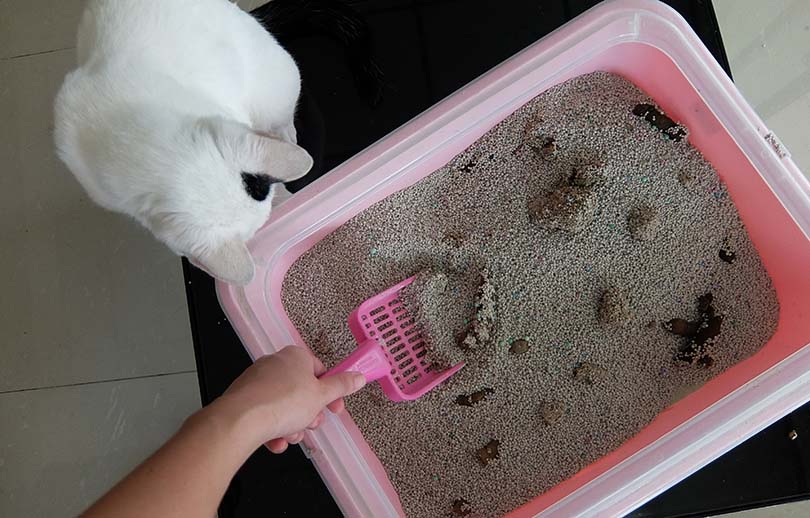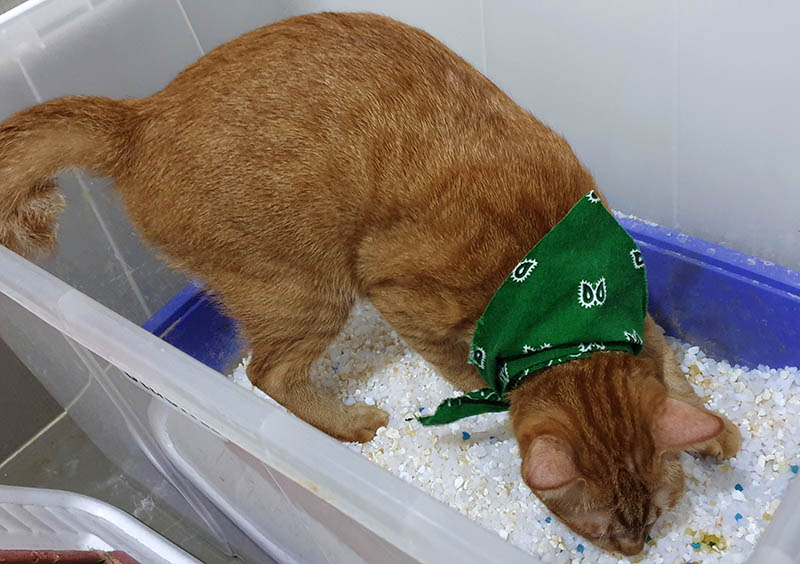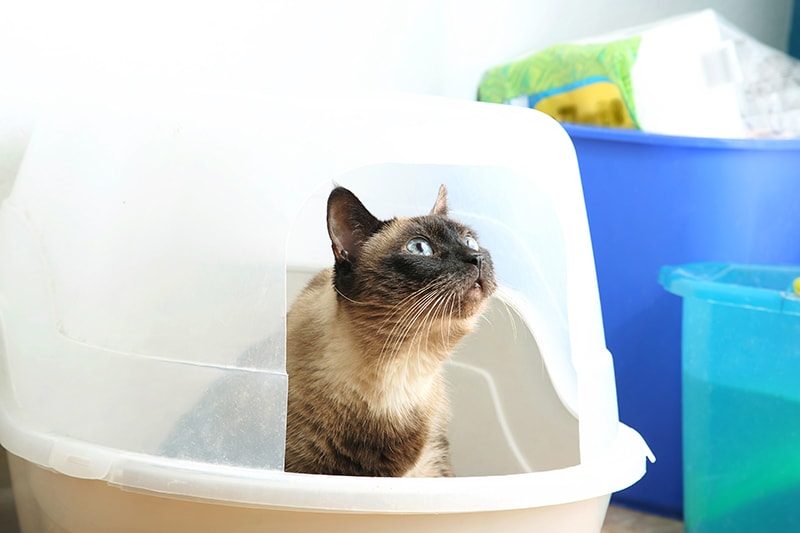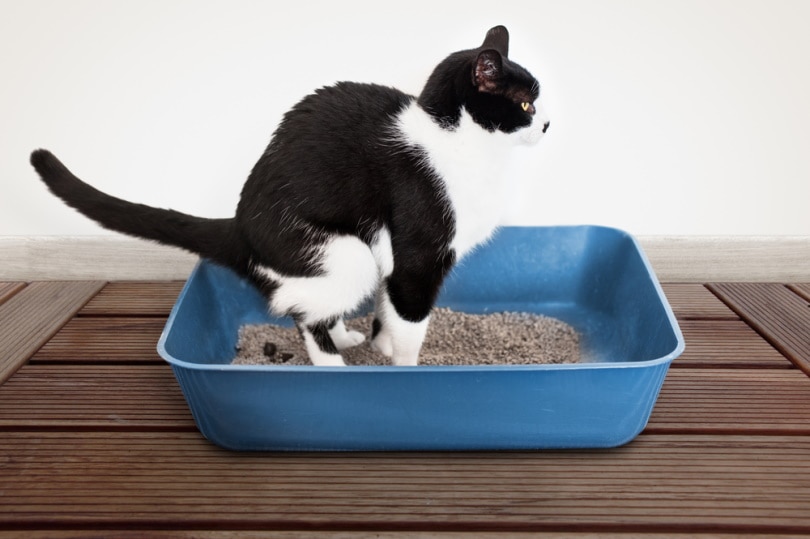
There are several health and safety rules to follow when you are pregnant, and it can feel impossible to keep track of them all. As strange as it may sound, you may have heard that scooping cat litter can be dangerous when pregnant—and it’s true. An infection known as toxoplasmosis may spread from your cat to you from your cat’s feces. Anyone can be infected with toxoplasmosis,1 but there are special risks for pregnant women.
What Is Toxoplasmosis?
Toxoplasmosis is a disease caused by a parasite called Toxoplasma gondii (T. gondii).2 If your cat eats a prey animal or raw meat infested with Toxoplasma, the parasite will then start reproducing inside the cat’s digestive tract and form oocysts (the next stage of the parasite development). 3 to 10 days later, these oocysts will be passed in the cat’s feces and continue to be shed this way for around 10 to 14 days. Humans may become infected through direct or indirect contact with the infested feces.
Most infected people display no symptoms.3 However, as your immune system fights the parasites, cysts will form in your body, and the parasite will live dormant inside these cysts, often for many years. If later reactivated,4 which usually occurs in immunocompromised individuals, the cysts can lead to signs of illness long after the initial infection.

How Is Toxoplasmosis Contracted?
Oocysts passed in the feces of cats are not immediately infectious to other animals. Before becoming infectious, they must go through a process called sporulation,5 which takes 1-5 days depending on environmental conditions.
Coming in contact with infested cat feces while cleaning out the litter box is one of the ways a person may become infected with toxoplasmosis.6 People can also contract this disease by eating contaminated foods,7 such as unwashed vegetables, undercooked or raw meat (especially pork, lamb, or wild game), or drinking water that contains sporulated oocysts. Other ways of becoming infected with Toxoplasmosis could be accidentally swallowing soil that has been contaminated with Toxoplasma or infested cat feces and rarely through contaminated blood transfusion or organ transplant. Congenital toxoplasmosis results from an often asymptomatic infection acquired by the mother during pregnancy.8
Toxoplasmosis is otherwise not directly contagious between two people.
Who Does Toxoplasmosis Affect the Most?
Again, anyone can be affected by toxoplasmosis. However, some people may experience more severe complications.
Pregnant Individuals
As already mentioned, pregnant women with an acute infection acquired during the course of pregnancy or reactivation of previous infection due to immunosuppression risk the possibility of transmitting toxoplasmosis to their unborn children. This can increase the risk of stillbirth, miscarriage, or birth defects, depending on when the infection was contracted during pregnancy. Toxoplasmosis in newborns may be severe, with a wide list of abnormalities, mostly affecting the brain, eyes, liver, and spleen, and leading to many mental and motor disabilities.
However, the transmission of Toxoplasma to a fetus is extraordinarily rare in immunocompetent healthy mothers who were infected with Toxoplasma and developed immunity prior to pregnancy. It is best to consult with your doctor on ways to protect yourself and your unborn child against Toxoplasmosis well in advance of planning a pregnancy.
Immunocompromised Individuals
A toxoplasmosis infection can also be severe for those who are immunocompromised. With the reduced ability of your immune system to fight back successfully, the parasite can cause brain, heart, lung, eye, skin, or other organ damage and can eventually lead to significant complications and death.

Types of Toxoplasmosis
The symptoms of toxoplasmosis may vary depending on whether the infection is newly acquired, reactivated, or present since birth and if the person is healthy or immunocompromised. Toxoplasmosis can be categorized into several main types.
Ocular Toxoplasmosis
If a person has ocular toxoplasmosis, their eyes have been infected with the parasite. This infection is most common in children or teens born with a congenital infection, but in rare instances, newly infected and immunocompromised individuals may also develop it. The most common symptoms include:
Acute Toxoplasmosis
Acute toxoplasmosis is when a person experiences signs of illness during an initial infection (first contact with the parasite). Many people with acute toxoplasmosis do not feel ill, but they may experience flu-like symptoms such as:
Central Nervous System (CNS) Toxoplasmosis
Most patients with AIDS or other immunocompromised patients who develop toxoplasmosis present with encephalitis (inflammation of the brain) and lesions are seen on CT or MRI scans. These patients typically experience:
CNS toxoplasmosis can also occur if a previous infection is reactivated in the brain of an immunosuppressed pregnant woman, leading to the above-listed symptoms and complications for the fetus.

Reactivated Toxoplasmosis
The infection may recur in people previously infected with the parasite, leading to reactivated toxoplasmosis. This occurs more often in immunocompromised individuals. Symptoms tend to be related to the spinal cord and brain, and they may include:
Congenital Toxoplasmosis
Congenital toxoplasmosis occurs in infants who were infected before birth. Some infants may not show symptoms until later in life. These mostly reflect damage to the brain, but other organs can be involved as well. Some of the most common symptoms include:

How Is Toxoplasmosis Treated?
Through a combined effort of anti-parasitic medication and antibiotics, the parasite can be prevented from reproducing in your body. Treatment will only be successful if the infection is active; it cannot eliminate the inactive cysts in your body. It may take anywhere from 2–6 weeks for the full effects of the treatment to be seen in cases of an acute infection. It may take three weeks to six months for brain injuries caused by the parasite to fully resolve, while treatment for congenital toxoplasmosis can last up to a year, and in people with weakened immune systems, can be given indefinitely.
If You Are Pregnant, What Does That Mean For Your Cat?
Considering how dangerous toxoplasmosis can be for an unborn child, should you consider rehoming your cat if you are pregnant? Absolutely not: there is no need for such drastic measures, and besides, your cat is part of your family.
However, without neglecting your cat’s needs, you should avoid cleaning your cat’s litter box.
If no one else in your home can clean your cat’s litter for you, you can wear disposable gloves and wash your hands with warm soap and water afterward. Ensure that the litter box is changed daily so the oocysts don’t get the chance to become infectious. Keeping your cat indoors will also significantly reduce their chances of an infestation with the parasite. Other preventative measures you can consider are to avoid feeding your cat raw or undercooked meats during your pregnancy, avoid contact with unfamiliar and stray cats, especially kittens, avoid adopting new cats while you are pregnant, and wear gloves when gardening and during contact with soil or sand as it might be contaminated with cat feces that contain Toxoplasma. Consult your doctor for any other health and safety recommendations.
Summary
Toxoplasmosis is a leading cause of foodborne illness-related death and hospitalization in the U.S.— causing hundreds of deaths and thousands of hospitalizations each year. This shows how important it is to educate the public and especially cat owners on this very important disease so you can protect yourself and still enjoy carefree cuddles with your cat.
While you are pregnant, you should avoid cleaning your cat’s litter box. Of course, that does not mean that your cat’s litter should not be cleaned at all. If others in the house can clean up the litter box daily, request that they do so for the remainder of your pregnancy. If you cannot find anyone who can clean your cat’s litter on your behalf, consult your doctor and take extra precautions when cleaning the litter box.
Featured Image Credit: Ninotee, Shutterstock







